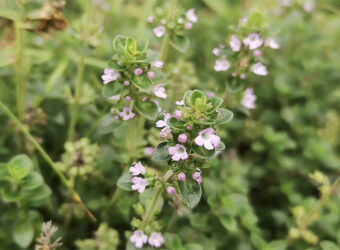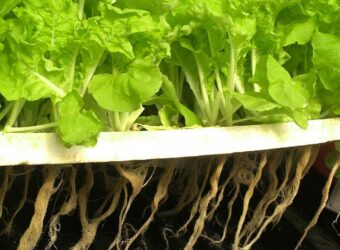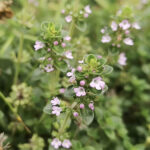Companion planting is growing more popular as a means to reduce the use of pesticides and attract pollinators. This is particularly true for small home gardeners.
What Is Companion Planting?
Companion planting (also called intercropping) is growing plants close together because of their ability to enhance each other.
Planting the three sisters (corn, beans, and squash) together is an example of intercropping that has been used for centuries.
Benefits of Companion Planting
Companion planting can benefit your garden in several ways.
- Trap Cropping
- Beneficial Insects
- Nitrogen-fixing
- Biochemical Pest Suppression
- Nurse Cropping
- Improving Soil
- Security in Diversity
Trap Crops
Trap crops are planted as a border around the cash crop (the desired crop), interspersed within the crop, or both. They must be more interesting to pests than the host plant.
Trap cropping primarily controls flying insects that find the trap crop first and settle there instead of on the crop you want. It may not be very easy to implement if you have a small garden.
Depending on what part of the plant the pests like, it may be necessary to plant the trap crop first so that part of the plant is available when the cash crop starts to come up.
Other trap crops can be planted at the same time as the cash crop.
Beneficial Insects
For trap cropping to work best, it is necessary to reduce the pest load on the trap crops. Nobody wants the pests on the trap crop to migrate to the cash crop.
It turns out that the trap crop attracts natural predators and parasites that then eat the pests.
An example of this kind of interaction is planting cornflowers in cabbage fields. Fields with cornflowers had reduced crop damage and an increased in yield.
Nitrogen Fixing
Legumes help fix nitrogen in the soil. This is supposed to help subsequent crops grow better. However, sometimes planting legumes with the current crop helps yield.
The traditional three sisters planting method takes advantage of this. The corn serves as trellises for the beans. The beans fix the nitrogen that corn uses. The corn also shades the squash to keep it from getting too hot. The squash grows rapidly and keeps the soil cool as well as keeps weeds down.
Legumes also kept down the weeds. The legumes blocked the weed plants without reducing the yield of the cash crop.
Biochemical Pest Suppression
Research has documented benefits from companion planting that include physical, chemical, and biological alterations to the environment that enhance desired plant species.
An example of companion planting is onions and lettuce. When planted together, the yield of both increases.
Sometimes, the companion plant emits a chemical that tells the cash crop pests are nearby. Then the cash crop emits an odor of its own that makes it taste bad to the pests.
Other times, the companion plant’s odor may mask the scent of the cash crop so the pests cannot find it. Some companion plants emit chemicals that affect the movement, feeding, and reproductive behavior of pests such as aphids.
Nurse Cropping
This is when one plant shelters another plant from the environment and increases the yield of the sheltered plant.
For example, with the three sisters, corn shades the squash plants from too much sun and from the wind. The squash plant can then use more energy producing squash.
Improving Soil
Planting vegetables with long roots can help break up heavy soil. The roots force spaces into the soil that water and air can use to penetrate the area.
When the plant rots or is pulled, those spaces are left. In addition, plants with long taproots can bring nutrients and water closer to the surface so other plants can use them.
Diversity In The Garden
When you plant companion plants, you change from having one crop in the garden to having a diverse array of plants. These cultivate a wide range of beneficial insects and plants and prevent one pest from devastating everything in the garden (an example is the Irish Potato Famine in the 1840s– monocropping killed thousands from starvation when the potatoes became diseased and inedible).
Examples of Companion Planting
As an example of trap cropping, in one experiment collard greens were planted around the borders of a cabbage field to protect the cabbage from diamondback moths (Lepidoptera plutellidae). The number of diamondback moths on the cabbage never got high enough to need spraying.
Fields of cabbage without the collard greens were used as a control. The control fields needed the standard amount of spraying with pesticides. The number of diamondback moths on the collard greens would have warranted spraying had they been the cash crop.
In laboratory experiments, some plants that emit scents can repel aphids. Plants in pots were placed around pepper plants in pots that were close but not touching.
In this example, onions and other members of the Allium spp strongly repelled the aphids from the pepper plants. Rosemary, African marigolds, geranium, lavender, basil, chives, and pot marigolds reduce the number of adult female and nymph aphids in similar conditions.
A field experiment planting white mustard or African marigolds around tomato plants found that both repelled root-knot nematodes. However, the white mustard decreased the tomato yield. African marigolds reduced the root-knot nematodes by 46.38% without reducing the yield of the tomatoes.
Collards bordered by catnip, wormwood, southern wood, or tansy had much less problems with flea beetles.
Planting such plants as basil, cilantro, dill, fennel, and parsley around the garden helps to increase the population of predatory and parasitic beneficial insects. These plants act as nurse plants for the insects that help remove pests. Those insects then migrate to the cash crop and remove pests from it.
In another experiment planted sunflowers around various organic crops. The strip of sunflowers was one meter wide. Each plot was ten acres. Tested were a single row of sunflowers, two rows of sunflowers, and a control plot with no sunflowers.
There were significantly more beneficial insects on the cash crops than there were in the control plot. These insects included anthropoid predators, parasitic wasps, and pollinators. The number of beneficial insects dropped off at the ten-meter range to match the control plot.
Companion Plant Chart
We have all seen tables of companion plants. The older tables are a result of a mix of observed horticultural science and some unconventional sources such as sensitive crystallization tests.
Sensitive crystallization tests were used in the middle of the 20th century to see if plants would work together well or if they must be separated.
Test plant extracts were mixed with reagents such as sodium sulfate or copper chloride. The mixture was placed in a controlled environment and allowed to evaporate. The residue created geometric forms and patterns.
These were studied to see if the plants were friends or foes. Plants with similar crystal forms were declared friends, while plants with different crystal forms were declared enemies. There is no evidence this is actually true.
The newer tables are research-based. Here are some of the findings about which plants work together and which ones do not get along.
| Plant Name | Companions | Enemies | Notes |
| Brussel Sprouts | Sage, dill, beets, peppermint, rosemary, corn, onion family, chard, spinach, sunflowers, nasturtiums | Fennel, strawberries, pole beans, tomatoes | Learn more about Brussel sprouts companion plants here. |
| Broccoli | Sage, dill, beets, peppermint, rosemary, corn, onion family, chard, spinach, sunflowers, nasturtiums | Fennel, strawberries, pole beans, tomatoes | Learn more about Broccoli companion plants here. |
| Cabbage | Sage, dill, beets, peppermint, rosemary, corn, onion family, chard, spinach, sunflowers, nasturtiums | Fennel, strawberries, pole beans, tomatoes | |
| Tomatoes | Sweet alyssum, calendula, dill, queen anne’s lace, cilantro, lettuce, radishes, basil, yarrow, bee balm, coneflower, buckwheat | Cucumbers, winter squash, and melons | Learn more about Tomato companion plants here. |
| Squash | Blue hubbard squash, corn, beans | Blue hubbard squash draws pests away from other squash. | |
| Cucumbers | Sweet Alyssum, Yarrow, Dill, Rye, Buckwheat, Radishes, Coneflower, Borage, Anise Hyssop, Mountain Mint | Lettuce, Arugula, Beets and more | Learn more about Cucumber companion plants here. |
| Radishes | Calendula, Peas, Nasturtium, Onions, Tomatoes, Lettuce, Marigolds, Peppers | Learn more about Radish companion plants here. | |
| Celery | Marigolds, Lettuce, Calendula, Sweet Alyssum, Peas, Arugula | Sage, Zucchini, Winter Squash | Learn more about Celery companion plants here. |
| Corn | Pole Beans, Squash, Cucumber, Dill, Melons, Borage, Marigolds, Mint, Nasturtiums, Thyme, Basil, Radishes, Sunflowers, White Clover, Lettuce | Tomatoes, Brassica Family, Eggplants, Fennel, Black Walnut | Learn more about Corn companion plants here. |
| Asparagus | Tomato, basil, parsley | ||
| Beans | Most vegetables and herbs | Onion, garlic, gladiolus | |
| Cantaloupe | Corn, sunflowers | Potatoes | |
| Eggplant | Beans, marigolds | Potatoes | |
| Artichokes | Asparagus, Brassica Family, Corn, Cucumbers, Hollyhock, Marigolds, Nasturtium, Peas, Queen Anne’s Lace, Sunflowers, Tarragon, Thyme, Vetch, Violets, Yarrow | Thistles, Fennel, Black Walnut | Learn more about Artichoke companion plants here. |
| Lettuce | Tomatoes, radishes, sweet alyssum, chives, scallions, beets, carrots, peas, peppers, eggplant | Cucumber, winter squash, melons, sweet potatoes, broccoli. | Learn more about Lettuce companion plants here. |
| Onion family | Beets, carrot, lettuce, cabbage family, tomatoes, strawberries, Summer Savory tomato, asparagus | Beans, English peas | |
| Potato, Irish | Beans, corn, cabbage family, marigolds, horseradish, peas | Pumpkin, squash, tomatoes, cucumber, sunflowers, raspberries | |
| Spinach | Strawberries | ||
| Strawberries | Bush beans, spinach, borage, lettuce (as a border) | Cabbage | |
| Beets | Onions, cabbage, chard, broccoli, cauliflower | field mustard | Learn more about Beet companion plants here. |
| Turnips | Mint, Brassicas, Garlic, Beans, Nasturtiums, Catnip, Thyme, Vetch, Radishes, Dill, Chives, Rosemary, Lavender, Celery, Marigolds | Potatoes, Horseradish, Beets, Mustard, Peas, Fennel, Black Walnut Trees | Learn more about Turnip companion plants here. |
| Rhubarb | Beets, Catnip, Dill, Alliums, Marigolds, Sage, Strawberries, Beans, Peppermint, Broccoli, Cabbage, and Related Plants | Sunflowers, Thistles, Cucumbers, Melons, and Pumpkins, Dock, Black Walnut, Fennel | Learn more about Rhubarb companion plants here. |
| Carrots | Calendula, Sweet Alyssum, Radishes, Tillage Radish, Rye | Dill, Cucumbers, Parsley | Learn more about Carrot companion plants here. |
| Peas | Radishes, carrots, com, cucumbers, beans | garlic, onions leeks, shallots | Learn more about Peas companion plants here. |
| Leeks | Carrots, Parsnips, Peppers, Melons, Tomatoes, Celery, Lettuce, Strawberries, Beets, Brassicas, Rosemary, Thyme, Chamomile, Nasturtiums, Marigolds | Beans, Peas, Black Walnut Trees, Fennel | Learn more about Leek companion plants here. |
| Peppers | tomatoes, eggplant, onions, carrots, basil | kohlrabi, fennel | |
| Chives | Chamomile, sweet alyssum, arugula, carrots, mustard greens, broccoli, calendula, bok choy, onions, beets | Peas, beans, winter squash | Learn more about Chives companion plants here. |
| Rosemary | Lavender, sage, oregano, marigolds, thyme, strawberries, brassica veggies, marjoram | Mint, garlic, onions, tomatoes, pumpkins, basil, cucumbers | Learn more about Rosemary companion plants here. |
| Chamomile | Cucumbers, garlic, beans, lettuce, onions, beans, marigolds, garlic and chives, tomatoes, thyme and sage, carrots and parsley, peppers, eggplant, and squash | Strawberries, radishes, cabbage and brussels sprouts, potatoes, beets and chard, fennel and dill, kale | Learn more about Chamomile companion plants here. |
| Dill | Lettuce, Broccoli, Onions, Radishes, Kale, Tomatoes, Cilantro | Cucumbers, Carrots, Melons | Learn more about Dill companion plants here. |
| Yarrow | Black-Eyed Susan, Purple Coneflower, Coreopsis, Broccoli, Cabbage, Cauliflower, Arugula, Rosemary, Lettuce, Tomatoes | Ginger, Cucumbers, Winter Squash | Learn more about Yarrow companion plants here. |
| Lemon Balm | Melons, Beets, Peas, Brassica Family, Tomatoes, Mint, Squash, Berries, Radishes, Carrots, Dill, Lettuce, Basil, Allium Plants, Okra, Fruit Trees, Thyme | Lavender, Fennel, Black Walnut, Rosemary | Learn more about Lemon balm companion plants here. |
| Borage | Basil, Bean, Cabbage, Cucumbers, Eggplant, Grapes, Marigolds, Melons, Peas, Peppers, Pumpkins, Radishes, Strawberry, Squash, Tomato | Potatoes, Fennel, Black Walnut | Learn more about Borage companion plants here. |
| Sage | Rosemary, Oregano, Thyme, Radishes, Lavender, Kale, Lettuce, Arugula | Celery, Ginger, Onions | Learn more about Sage companion plants here. |
| Bok Choy | Beets, Borage, Bush beans, Carrots, Celery, Chamomile, Garlic and Onions, Lettuce, Nasturtiums, Peas, Rosemary, Peppermint, Sage, Spinach, Thyme | Other Brassicas, Fennel, Tomatoes, Strawberries, Pole Beans | Learn more about Bok Choy companion plants here. |
| Lemon Grass | Mint, Basil, Lemon Verbena, Ginger, Marigolds, Echinacea, Peppers, Tomatoes, Tomatillos, Bee Balm, Cilantro, Hops, St. John’s Wort, Limes, Goji Berries | Lavender, Thyme, Fennel, Rosemary, Sage | Learn more about Lemon Grass companion plants here. |
| Cantaloupe | Alliums, Basil, Pole Beans, Bee Balm, Borage, Carrots, Cilantro, Corn, Dill, Lettuce, Marigolds, Mint, Nasturtium, Oregano, Radishes | Cucumbers, Fennel, Potatoes, Squash, Watermelons | Learn more about Cantaloupe companion plants here. |
| Thyme | Alliums, Blueberries, Brassicas, Beets, Chamomile, Corn, Eggplant, Lavender, Lettuce, Marjoram, Oregano, Roses, Rosemary, Potatoes, Strawberries | Mint, Cilantro, Fennel, Basil, Cucumbers | Learn more about Thyme companion plants here. |
How to Apply Companion Planting
Companion planting tables are a place to start, but you should record what you plant where.
Make notes all season about yields and growth. Use these results to guide your next plantings.
Companion planting is not an exact science so you will have to experiment to see what works best in your area.
Common Companion Planting Mistakes
Companion planting is as much an art as a science. Here are some mistakes to avoid when gardening.
Crowding Plants
Companion plants should be within two to three rows of their companions. However, think about the size of the plants will be as adults.
Don’t plant marigolds too close to tomatoes when they are young plants, because they will be too close when the tomatoes are mature plants.
Water Stealing
If companion plants are too crowded, the ones with the longest roots will take the water away from the other plants.
Be sure to irrigate your plants adequately, so there is enough water for everyone. Do not overwater, however, or you will cause root rot in your plants.
Nutrient Availability
By the same token, stronger and more vigorous plants will steal nutrients from less aggressive plants. Make sure that you do a soil test every year and fertilize according to the recommendations.
Provide fertilizer for all the plants, so none of them starve. However, if you overfertilize, you will get lots of foliage and not many vegetables.
Shade
Plants that are planted too close to tall plants like tomatoes, corn, and okra can be shaded out of their sunlight. While some late afternoon shade can be beneficial, too much shade will keep your shorter plants from growing.
For example, beans planted too close to tomatoes will be in too much shade to yield as many beans as they would in full sun.
Allelopathic Plants
Some plants produce compounds that harm or even kill other plants.
Black walnuts are a classic example. The toxin black walnuts produce is so potent that it lasts several years after the tree is removed.
For another example, beans and onions inhibit each other’s growth. Fennel should be given its own little corner of the garden and not grown near other plants.
Competing pH
Some plants grow best in alkaline soil, and some other plants need more acidic soil.
For example, blackberries need alkaline soil while blueberries need acidic soil. You cannot grow them next to one another.
Pay attention to your soil pH and plan your garden accordingly.
Poor Timing
Some companion plants need to be planted at the same time while others need to be staggered.
For example, you can plant lettuce beside tomato plants at the same time, and the lettuce will be ready to harvest before the tomatoes shade the ground around them.
Corn, on the other hand, needs to be planted and allowed to grow before beans, which need to climb the corn, are planted.
Squash is planted after the beans so they will not shade the beans too much before the beans climb the corn.
Aggressive Companions
Some plants just don’t play nicely and need to be separated from your vegetable garden.
For example, mint is notorious for taking over the vegetable garden. It should only be grown in a pot.
Other aggressive plants include clover, bamboo, blackberries, and morning glories.
Mixing Perennials and Annuals
Perennials are plants that live for many years while annuals are plants that only live a year. Some vegetables are biennials, who live out their lives over two years. These include onions, cabbage, and broccoli. They are grown as annuals, so I include them with other true annuals.
Perennials can get quite large and take over the garden space if you are not careful. Plant them on the borders of the garden to attract beneficial insects and pollinators such as butterflies and hummingbirds.
Use your vegetable garden space for annuals. If you grow asparagus and other perennials like artichokes, place them at one end of the garden, usually the north end in North America, so they don’t shade out your other plants.
Not Using Rows
It is tempting to plant your vegetable garden in clumps or curves. Plant your vegetable garden in rows and leave the clumps or curves for your landscape beds.
Rows are easier to weed and maintain. They also let you look at your plants from all sides to make sure they are healthy and pest free.
The exception to this rule is square foot gardening, which uses one square foot squares instead of rows.
Match Maintenance Requirements
Plants with wildly different maintenance requirements should be planted apart, while plants with similar maintenance requirements should be planted together.
For example, potatoes need to be hilled. If you plant broccoli or onions, which don’t need to be hilled, next to them, these plants can get damaged by dirt from the hills.
It can also be difficult to get a shovel or pitchfork in when the other crops are too close. Make sure you have room to maintain each crop the way it needs to be maintained.
Wasting Space
For small gardens, it is important to maximize the use of your space. Trellis vining crops like tomatoes, cucumbers, winter squash, and even watermelons and cantaloupe.
For larger fruit, like watermelon, use pantyhose to support the fruit, so it doesn’t tear off the vine.
If you plant tomatoes and cucumbers, you can often grow lettuce or radishes around them and harvest these crops before the tomatoes and cucumbers shade the ground. This allows you to grow two crops in the space instead of just one.
Separate Closely Related Crops
Pests like similar crops. If you plant all your broccoli, cabbage, and cauliflower together, pests can just hop from one to the next. If you separate those crops with different companions, you can create a barrier to keep one pest from infesting all of them.
For the same reason, you are not supposed to plant related crops where a relative has grown in the last three years. For someone with a small plot, this ideal may not be possible, but it is a goal.
Too Many Plants
Plant people love plants. It is tempting to cram every type of vegetable and flower you want to grow in your plot. This can result in a crowded garden where plants do not have the space to spread out and grow.
If air cannot circulate around plants, they are at greater risk of diseases. You may not be able to grow everything you want to grow every season. Only grow what fits and what you can keep healthy and happy.
Failure to Keep Records
If you do not keep records of what you are growing, how the plants are producing, and what crops fail, you are making a mistake.
You may think you will remember what worked and what didn’t, but you will forget everything when you see the first seed catalog next spring.
You need notes to go back to in order to remember what happened last year. Do yourself a favor and record your observations every day when you go into the garden, or at least once a week.
You will be grateful next spring if you do.
Final Verdict
In conclusion, companion planting can benefit your garden if you use research-based companions. Old companion planting tables may be based on pseudoscience that has no basis in reality. More modern tables that are research-based are useful.
Extension services are increasingly doing research on companion planting, the chart above is based on Extension publications. Companion planting is part art, part science. Experiment and see what combinations work in your garden and keep records of your results.
Using flowers and herbs judiciously in the vegetable garden can attract more pollinators and more beneficial insects. Be mindful of space requirements and don’t crowd your plants to prevent diseases.
Finally, don’t forget to have fun. That is what gardening is all about.






